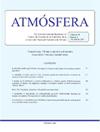使用热带降雨测量任务(TRMM)和ERA印度尼西亚中期降水预报数据对麦登-朱利安振荡(MJO)和对流耦合赤道波(CCEW)的预报精度的比较
IF 1
4区 地球科学
Q4 METEOROLOGY & ATMOSPHERIC SCIENCES
引用次数: 0
摘要
使用二阶自回归AR(2)和时空谱分析方法分析的热带降雨测量任务(TRMM)和ERA中期预测数据(分别)显示了预测印度尼西亚上空麦登-朱利安振荡(MJO)和对流耦合赤道波(CCEW)现象的对比结果。本研究使用了欧洲中期天气预报中心(ECMWF)的13年系列每日TRMM 3B42 V7衍生数据集和ERA中期再分析模型数据集进行降水预报。然后使用三年(2016年至2018年)的过滤3B42和ERA中期预测数据,通过查看从第+1天到第+7天的预测线索的相关系数来评估预测准确性。结果表明,3B42的降雨量估计数据对较短的预测导联提供了更好的结果,特别是对MJO、赤道Rossby(ER)、混合Rossby重力(MRG)和纬向波数1(IG1)中的惯性重力现象,但对所有预测导联的Kelvin波的相关性较差。从过滤后的ERA中期降水量预测模型中获得了所有波浪的一致相关性,尽管这在第一个预测导联中相当弱,但在除IG1外的后续预测导联中没有达到负相关性。此外,还计算了均方根误差(RMSE),以补充这两个数据源的预测技能,结果是,在所有预测超前和所有波浪类型中,过滤ERA中期降水量预测的残差RMSE都很小。这些发现证明,ERA中期降水量预测模型在热带地区仍然是MJO和CCEW预测的适当降水量模型,特别是在印度尼西亚。本文章由计算机程序翻译,如有差异,请以英文原文为准。
Comparison of forecasting accuracy for Madden Julian Oscillation (MJO) and Convectively Coupled Equatorial Waves (CCEW) using Tropical Rainfall Measuring Mission (TRMM) and ERA-Interim precipitation forecast data for Indonesia
Tropical Rainfall Measuring Mission (TRMM) and ERA-Interim forecast data analyzed using second-order autoregressive AR(2) and space-time-spectra analysis methods (respectively) revealed contrasting results for predicting Madden Julian Oscillation (MJO) and Convectively Coupled Equatorial Waves (CCEW) phenomena over Indonesia. This research used the same 13-year series of daily TRMM 3B42 V7 derived datasets and ERA-Interim reanalysis model datasets from the European Center for Medium-Range Weather Forecasts (ECMWF) for precipitation forecasts. Three years (2016 to 2018) of the filtered 3B42 and ERA-Interim forecast data was then used to evaluate forecast accuracy by looking at correlation coefficients for forecast leads from day +1 through day +7. The results revealed that rainfall estimation data from 3B42 provides better results for the shorter forecast leads, particularly for MJO, equatorial Rossby (ER), mixed Rossby-gravity (MRG), and inertia-gravity phenomena in zonal wavenumber 1 (IG1), but gives poor correlation for Kelvin waves for all forecast leads. A consistent correlation for all waves was achieved from the filtered ERA-Interim precipitation forecast model, and although this was quite weak for the first forecast leads it did not reach a negative correlation in the later forecast leads except for IG1. Furthermore, Root Mean Square Error (RMSE) was also calculated to complement forecasting skills for both data sources, with the result that residual RMSE for the filtered ERA-Interim precipitation forecast was quite small during all forecast leads and for all wave types. These findings prove that the ERA-Interim precipitation forecast model remains an adequate precipitation model in the tropics for MJO and CCEW forecasting, specifically for Indonesia.
求助全文
通过发布文献求助,成功后即可免费获取论文全文。
去求助
来源期刊

Atmosfera
地学-气象与大气科学
CiteScore
2.20
自引率
0.00%
发文量
46
审稿时长
6 months
期刊介绍:
ATMÓSFERA seeks contributions on theoretical, basic, empirical and applied research in all the areas of atmospheric sciences, with emphasis on meteorology, climatology, aeronomy, physics, chemistry, and aerobiology. Interdisciplinary contributions are also accepted; especially those related with oceanography, hydrology, climate variability and change, ecology, forestry, glaciology, agriculture, environmental pollution, and other topics related to economy and society as they are affected by atmospheric hazards.
 求助内容:
求助内容: 应助结果提醒方式:
应助结果提醒方式:


